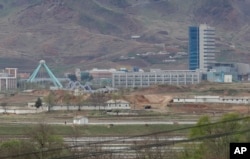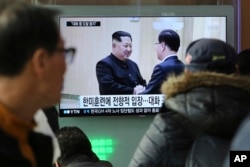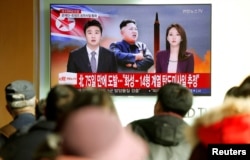North Korea should give up five nuclear bombs, which would make up an estimated ten percent of its estimated arsenal, to prove it is serious this time around about halting its nuclear program. This would be an initial trust building step in the long-term negotiation process to follow, according to a proposal from Bruce Bennett, a defense analyst and expert on the North Korea military at the RAND Corporation research organization in California.
“What the U.S. is looking for is real denuclearization. So my proposal has been, if Kim Jong Un is serious, he probably has 30 or 50 or 60 nuclear weapons, why doesn’t he take five of them and give them up?” asked Bennett at the Asan Plenum security forum in Seoul on Tuesday.
Broken promises
North Korea’s pivot this year from confrontational nuclear and ballistic missile tests to diplomatic outreach has greatly reduced the potential for military conflict in the region.
North Korean leader Kim Jong Un seems to be pursuing a peaceful resolution to the nuclear stand-off by expressing a willingness to give up his country’s nuclear weapons program for security guarantees and sanctions relief, and to engage in high level talks, recently with Chinese leader Xi Jinping, later this week with South Korean President Moon Jae-in and with U.S. President Donald Trump soon after.
However North Korea’s reassuring words and actions, including its recent decision to suspend further nuclear and intercontinental ballistic missile tests, and to shut down its nuclear test site, has been met with skepticism by many analysts and officials, who say these measures were part of failed nuclear deals of the past.
“For those of us who have been following this issue for many years, if not decades, thus far we have not heard anything new,” said North Korea scholar Victor Cha at the Asan forum in Seoul on Tuesday.
Cha, a professor at Georgetown University and national security adviser to former President George W. Bush, was recently dropped from consideration to be named U.S. Ambassador to South Korea over a policy difference with the Trump administration’s emphasis on the possible use of force against North Korea.
Back in 1994, North Korea agreed to freeze its fledgling nuclear capabilities, and dismantle its nuclear reactor in Yongbyon for international aid. It was later discovered that Pyongyang was secretly continuing work on its nuclear program and restarted the nuclear site in 2003.
North Korea followed the same pattern in 2007, by promising again to shut down its nuclear reactor for financial assistance, and then later walking away from the deal.
While this week’s inter-Korean summit is expected to produce a joint commitment to denuclearization, it is unclear that a deal can be developed that would satisfy Washington’s demand for complete, verifiable and irreversible nuclear dismantlement before reducing sanctions, yet still provide Pyongyang significant incentives to comply.
10 percent solution
Bennett’s suggestion for a 10 percent solution, giving up five of its 50 or so estimated nuclear devices, would be a grand gesture on Kim’s part that would move beyond past proposals. Such a move could be implemented quickly, and would actually reduce North Korea’s nuclear capability, although not significantly.
In accordance with the international Treaty on the Non-Proliferation of Nuclear Weapons, the nuclear devices would then be transferred to a recognized nuclear state, perhaps France, said Bennett, as it might be seen as a neutral party.
One benefit in this for North Korea is that international experts could study the devices, and possibly verify Pyongyang’s claims to possess the capability to mount miniaturized nuclear warheads on ballistic missiles.
Demonstrating a real North Korean nuclear reduction could also give President Trump the tangible proof of denuclearization progress that he is demanding.
“I do think that it’s something President Trump is looking for. He is looking for a bold gesture, something that he could point to, that shows that he has really achieved something, and that North Korea is in fact moving towards denuclearization,” said Bonnie Glaser, a security analyst with the Center for Strategic and International Studies in Washington.
Asymmetrical concessions
Kim’s motivation for engaging in nuclear talks is to end the tough international sanctions imposed in the last year that banned billions of dollars of North Korean exports, including its lucrative coal and seafood industries.
However, Bennett notes that offering North Korea a 10 percent reduction in economic sanctions for five nuclear weapons would not be a fair trade, as sanctions relief would provide significantly more benefit, while the loss of a few nuclear bombs would not reduce the threat level.
“It is asymmetric. It is a small change for them. It may be a big change on the sanctions, which is why I believe the administration is talking about waiting on the sanctions until much more is done,” said Bennett.
The U.S. and South Korea could offer diplomatic incentives instead, he said, such as increasing official contacts through third party embassies in Pyongyang until a detailed denuclearization framework is in place.
Lee Yoon-jee in Seoul contributed to this report.












